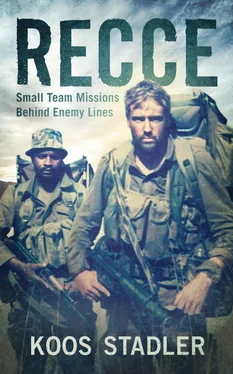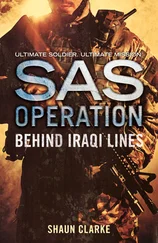One week before the infiltration we were airlifted to Katima Mulilo for final preparations and briefings. We spent most of our time in the ops room at Katima, planning routes and emergency procedures, and preparing maps for the deployment. We deployed from Mpacha Air Force Base before last light one day late in February 1979.
The Super Frelon dropped us in an omuramba 30 km southwest of our target area. It was a strange feeling, just the four of us in the belly of the huge helicopter, flying into the unknown. The adrenaline was pumping, as I had no idea what to expect. After twenty minutes we reached the landing zone (LZ). As we ran down the ramp into the field of small mopane trees outside, I was half expecting the enemy to be waiting to mow us down, but nothing happened.
The bush was quiet. And hot. And as the sound of the helicopter faded in the distance, an utter loneliness engulfed me – as if I was left alone in a noiseless world.
But I had no time to ponder this feeling, at least not right there. It would become a familiar sensation that I would experience a thousand times over, often in situations much more threatening than this. We waited until after last light to ensure that there was no immediate reaction, and then started moving in the direction of the target.
The operation would last for two weeks, as we had quite a large area to cover. Frannie’s plan was to look immediately for signs of the enemy along the main road curving along the Zambezi River; he reasoned that any sizable force needed to be supplied, and would therefore require some form of logistics. The local population was spread along the Zambezi, while the only road negotiable by vehicle was the one running parallel to the river on its western bank. Once we had located signs of enemy presence, we would turn our focus on them to locate the base.
We circled the area from the north, first moving along the slopes of an omuramba leading east towards the river, then cutting in along the road moving south. After seven days, having covered a 30-km stretch along the river, we still hadn’t found any sign. Either the information was wrong or the base was further south. Frannie called for a pick-up, which was pointedly denied, as we were supposed to deploy for fourteen days.
An argument ensued, as the Tactical HQ (commonly referred to as Tac HQ) demanded to know whether we had actually covered the whole forest area away from the river. The more Frannie tried to explain that it wasn’t necessary, since we had covered all the possible entrances, the more they insisted that we patrol the actual bush.
To me it seemed ridiculous to stay for another seven days if we knew the base wasn’t there. It would make more sense to go back, reassess where the enemy could be and deploy again. Little did I know that this would be only the first of many similar situations. In fact, it was quite common for the bosses at headquarters to think they knew better than the guy on the ground risking his life.
During the two days we waited in the lush green bush for a decision on whether our job was done or not, I had another unique experience with the Bushmen. Tango Naca had kept a close eye on a little bird from the moment we moved into our hide. The bird twittered and darted around us, and then flew off, only to come back after a while and frantically flap its wings. At first I thought Tango was irritated by the little bugger, as it could give our position away.
But then he approached Frannie and whispered something to him, to which Frannie nodded his head and gave him a thumbs up. Tango indicated to me to follow him and Dumba as they set off after the excited bird. After about a kilometre the bird started going mad, circling us and constantly going back to a fallen tree we had passed. Tango’s face lit up and a huge smile spread across his wrinkled features as he formed the word, “Honey!”
The Bushmen had a fire going in no time, and then made a crude smoke generator with green leaves wrapped around a burning branch. While I kept a lookout, the two Bushmen went about with their hunting knives, cutting away at the branches and then digging into the tree trunk that concealed the golden combs of honey.
Finally they managed to pull some of the combs from the tree trunk, stacking them on a large piece of fresh bark that served as a tray. We carried the honey back to the hide, and soon feasted on the pure golden sweetness from the bush. The syrup and large chunks of honey that we could not finish were stored in water bottles and taken back to base the following day – once the Tac HQ had finally agreed to extract us.
My first real contact with an enemy force took place during a deployment just north of the Matabele Plains in southern Zambia. SWAPO had established a number of training bases and transit camps in the relatively safe area of Ngwezi Pools. Our deployment formed part of a much bigger operation conducted by Sector 70 from its headquarters at Katima Mulilo.
Operation Saffraan was launched on 7 March 1979, concurrent with Operation Rekstok into Angola. The operation was partially in retaliation for the SWAPO attack on Katima Mulilo the year before, as well as for the frequent incursions into the eastern parts of the Caprivi at the time. As one of the main actors taking part in the offensive, 31 Battalion was tasked to deploy its companies in a wide-sweeping area operation against SWAPO bases between the Kwando and Zambezi rivers, while the recce teams were to act as cut-off groups north of the Matabele Plains.
With three teams of six each, we formed a fighting patrol of eighteen guys geared up for serious fighting. We knew that there was an elite SWAPO unit called Typhoon rehearsing in that area. Typhoon specialised in deep infiltrations into the farmlands of South West Africa, where they would attack farmsteads and harass local communities.
Our mission was to find elements of this group and hunt them down. We infiltrated by helicopter and, over the following week, did a wide sweep of the bush from where the group allegedly operated. On the third day we started picking up signs of guerrilla activity. Tracks of SWAPO soldiers often led into and out of the local kraals, although we could never pinpoint the guerrillas.
Towards the end of the first week we decided to use our resupply as a ruse to make the enemy believe we had left the area. At a cluster of kraals, in broad daylight and in full view of the population, we started moving south. We left a clear track and made it quite obvious that we were leaving. That afternoon, about ten kilometres further south, we called in the helicopters for a resupply. Afterwards, we meticulously wiped out all signs of our presence. We split up into teams again and decided on an RV where we would meet the following day. Each team then applied anti-tracking techniques and circled back to the predetermined RV.
After stealthily joining up at the RV, we decided to keep a low profile and not make our presence known. We sent out small patrols to locate signs of enemy presence, and were soon rewarded when a team reported fresh tracks going into a kraal complex. We circled the kraal to the opposite side from which the enemy patrol had entered. Frannie then deliberately exposed two of the Bushmen, dressed up in SWAPO attire, to the inhabitants of the kraal, whereafter we pretended to withdraw, and then moved into a thicket not far from the kraal complex.
The SWAPO patrol, not knowing whom they were dealing with so far from the South West African border, took the bait – hook, line and sinker. They aggressively pursued us into the bush. And we were ready. The patrol approached us in line-abreast formation, so by the time Frannie initiated fire we had the nearest ones covered. The one I had in my sights was barely 20 m away. Along with four others he went down under the initial high volume of fire, while the rest started scrambling in all directions.
Читать дальше












